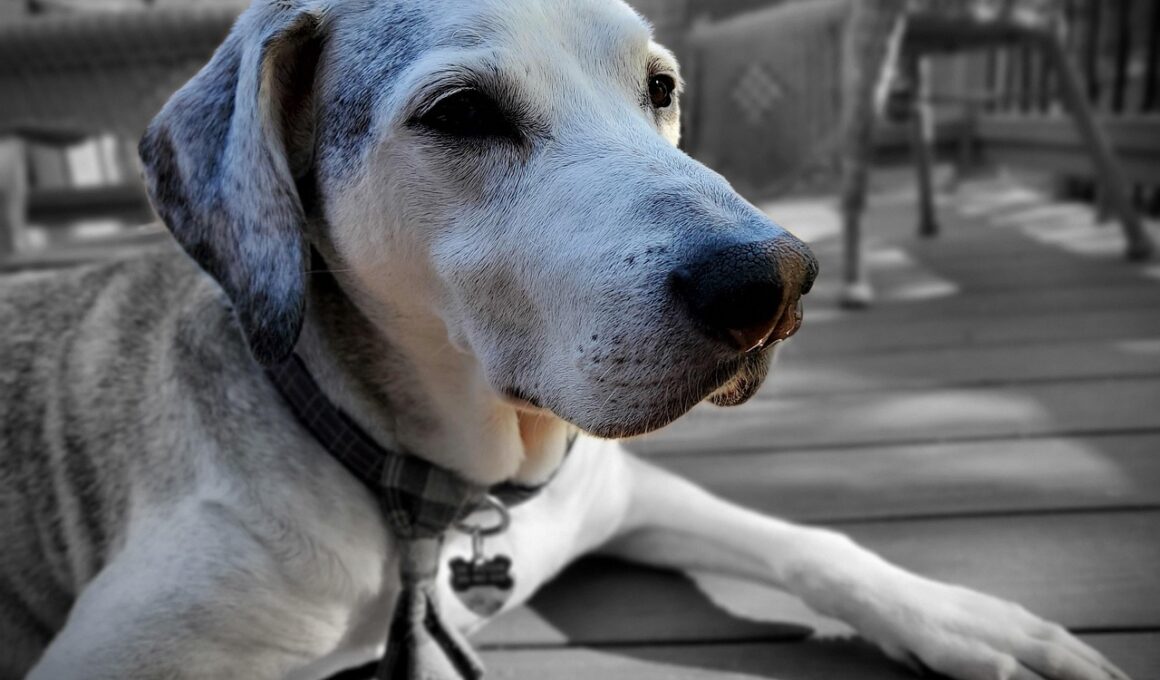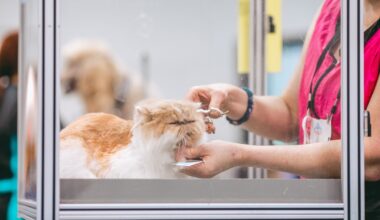Training Senior Dogs for Comfortable Car Rides
Long car rides can be daunting for senior dogs. Unlike younger dogs, seniors may experience various health issues that make travel more complicated. It’s important to approach car rides with consideration for their unique needs. Start with short trips to allow your dog to acclimate without stress. You can gradually increase the duration of these trips once your dog feels more comfortable. Prepare your car by making it a safe and welcoming space. Consider providing a dog seat cover to prevent sliding around and create a secure area for your pet. Furthermore, don’t forget about maintaining a comfortable temperature in the vehicle during travels. A well-ventilated space is essential for their well-being. Carry water, treats, and waste bags to ensure that you can address their needs during stops. Your senior dog might appreciate extra soft bedding and their favorite toys for comfort while traveling. This can also reduce anxiety significantly. Always observe your dog’s reactions and feelings during trips, adjusting your approach as needed to cater specifically to their comfort. This will contribute to a more enjoyable car ride for both of you.
Understanding Your Senior Dog’s Needs
As dogs age, their physical and emotional needs change significantly. Before embarking on car rides, discern your senior dog’s specific requirements. For instance, older dogs may struggle with mobility, making it more challenging for them to jump into the car or find a comfortable position during the ride. You can ease this process by providing ramps or using a dog seat booster to help them comfortably access the vehicle. Additionally, pay attention to any signs of distress or anxiety during these rides. Knowing when your dog is feeling uncomfortable allows for necessary interventions. Regular check-ups with your vet can also provide insights into the best practices for ensuring their comfort. Discuss any concerns or changes in behavior with a professional who understands your pet’s history. Another crucial aspect to consider is their medication routine. If your senior dog requires any medication, ensure that you plan trips accordingly to maintain a consistent schedule. This can include bringing medications with you for longer trips or planning stops where you can safely administer necessary dosages. Keeping your dog’s routine as normal as possible will help them feel secure.
To ensure your senior dog enjoys their travel experience, it’s crucial to create positive associations with the car. One effective method involves rewarding your dog with treats for getting into the vehicle. This helps them form a positive connection with the space, making it less intimidating over time. On short trips, let your dog explore the car while stationary to help them adjust without the added stress of movement. Gradually introduce the car’s motion by taking brief rides followed by praise and rewards. Over time, you can progressively increase the ride length while encouraging calm behavior. Maintaining a safe and comfortable environment during travels is essential. Make sure your dog is secured using a harness or a pet seatbelt to prevent injuries in case of sudden stops or accidents. Additionally, never leave your dog unattended inside the car, especially during warmer weather, which can lead to serious health issues due to overheating. Provide regular breaks during longer trips to stretch paws and relieve themselves. These breaks also offer opportunities for physical and mental engagement while enjoying different surroundings.
Training Techniques for Relaxation
Teaching your senior dog to relax during car rides is a key component of successful travel. Incorporate training techniques focused on relaxation, such as the “settle” command. Start by practicing this command while at home in a calm environment before applying it to the car setting. Utilize comfortable bedding within the car to encourage your dog to lie down. Reinforce this behavior with treats and praise. Consider playing calming music or using aromatherapy products created specifically for dogs to alleviate anxiety during travel. This can create a peaceful atmosphere that helps soothe your pet’s nerves. Another beneficial method is to implement desensitization techniques. This involves exposing your dog to the car while stationary and gradually progressing to short rides. This assists in slowly acclimating them to the travel experience. Keeping familiar items, such as blankets or toys, in the car will provide comfort and familiarity during the rides. If issues arise, ensure that travel remains a stress-free experience by not forcing your dog to participate until he feels more comfortable. With consistent practice and patience, it’s possible to achieve a relaxed dog during car rides.
Safety during car rides should always be a primary concern. Besides providing a secure space for your furry friend, staying prepared for emergencies is vital. Ensure that you’re equipped with a pet first aid kit when traveling. This kit should include essential items such as bandages, antiseptic wipes, and any specific medications your senior dog may require. Familiarizing yourself with basic first aid measures can also make a significant difference in emergency situations. Before embarking on your journey, conduct a pre-trip inspection of your vehicle to ensure everything is in order, from the tires to engine fluids. It’s advisable to have your pet’s emergency contact and veterinary information readily accessible in case of an emergency. Regular breaks during longer trips are also important for your senior dog’s health; they can relieve themselves, hydrate, and stretch their limbs. Adequate hydration is essential, so make sure to offer fresh water frequently. Every dog deserves respect and care while traveling. Prioritizing their comfort and safety ensures a pleasant experience and provides peace of mind for both pet owners and dogs alike.
Conclusion and Encouragement
In conclusion, training senior dogs for comfortable car rides involves patience, understanding, and commitment. By observing their unique needs, you can create a positive, safe environment that enriches their car travel experience. Focus on introducing gradual adjustments to their travel routines, ensuring that they feel safe and comfortable with encouragement and rewards. Consistency in training leads to profound improvements in how your senior dog reacts to car travel. If they’re motivated by treats or praised for being calm, the journey becomes more enjoyable for both you and your pet. Don’t hesitate to consult with a professional dog trainer if challenges arise. Every dog has individual preferences and may require a customized approach to learning. Remember to celebrate the small achievements, recognizing their progress along the way; this will help both you and your dog grow closer. A pleasant travel experience not only enhances their quality of life but also strengthens your bond. So embark on your next adventure! With a little effort and creativity, you can transform car rides into a joyful experience for your beloved senior dog.
Now that you have some strategies for training your senior dog, let’s summarize the essential tips discussed. Start by assessing your dog’s specific needs and create comfort in the car. Utilize positive reinforcement to encourage behaviors that promote a pleasant travel experience. Use relaxation methods and gradually acclimate your dog to the vehicle. Investing in safety measures, providing secure spaces, and being prepared for emergencies is essential for every trip. Focus on maintaining a familiar and calm environment while traveling with your senior dog, ensuring they feel at ease. Tailoring your strategies to their individual behavior and preferences also encourages successful travel experiences. Regularly incorporate breaks, allowing them to rest, stretch, and hydrate, is key for their well-being during longer trips. Finally, remain patient throughout the training process and take gradual steps toward comfortable car rides. Remember that progress might be slow, but with consistency, your senior dog will learn to enjoy the rides together, making every adventure worthwhile for both of you. Training can lead to wonderful memories, enhancing the bond and trust between you and your senior companion.
For additional resources and information related to training senior dogs for car rides, consider visiting reputable dog training websites. Organizations like the American Kennel Club provide articles and resources on dog training best practices and tips specifically for senior dogs. Online forums and communities can also serve as valuable support systems for dog owners. They offer an excellent venue to share experiences, obtain advice, and exchange strategies with others in similar situations. Explore local training classes in your area where you can connect with professional trainers specializing in senior dogs and their unique needs. Remember that every senior dog is different, and their training needs may vary greatly depending on health and personality. Finding the right support and protocol can facilitate a stress-free journey for your pet. Gather all necessary information, and never hesitate to seek professional assistance if needed. Car rides can become cherished experiences filled with love and joy. Providing your furry friend with the best experience not only ensures their happiness but deepens your relationship with them as well. Every adventure holds the potential for discovery and connection.


